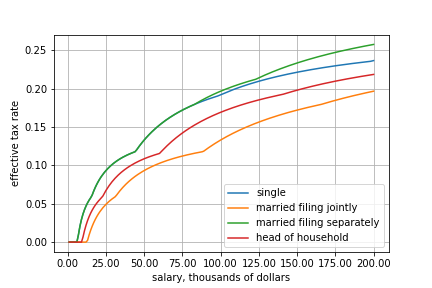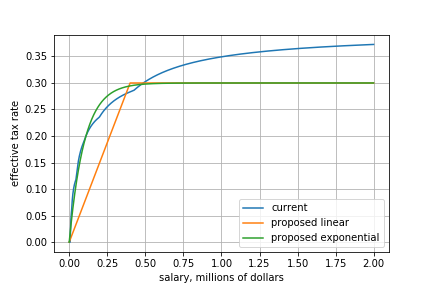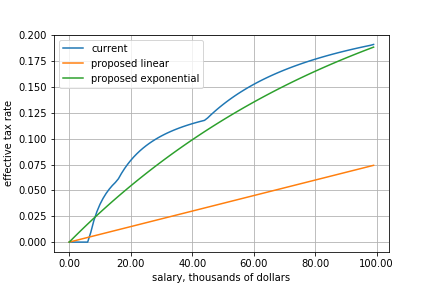
Alternate Tax Proposals

Unfortunately, each of us only 24 hours in a day. You try to sleep for 8 of those. You probably work for another 8. Maybe you spend another couple of hours preparing food and eating it. Don't forget time for the kids, the spouse, the bills, and - of course! - reading this blog. Oh, and you are expected to maintain a continual financial record of all of your dealings throughout the year so that you can justify your particular tax situation to the government.
Sounds like fun.
In this article, we are going to present a couple of tax strategies that would greatly simplify the tax burden along with allowing more automated adjustment of taxes by simplifying the tax calculation.
Are Taxes Complex?
Just speaking the lingo of the tax system can be exhausting. The most basic interactions with the IRS involve deductions, credits, exemptions, types of income, qualified vs. unqualified, alternative minimum tax, and a million other things. There are numerous articles on the web for a hundred different specific tax situations.
Oh, and single vs. married filing separately vs. married filing jointly vs. head of household...
You have to wrangle with those terms before you even begin to determine your bracket and, even then, calculating your actual taxes is an annoyingly difficult process!
Let's go through a really simple example. You should know that I'm not a tax professional, so this may be off. In a way, that is sort of making my point... why can't the average middle schooler calculate taxes? I digress... We will start with citizen Brian. Brian makes $56,580 in 2017 assembling cars.
Standard Deduction: $6,350
| 2017 bracket | 2017 rate |
|---|---|
| up to $9,325 | 10% |
| $9326 to $37,950 | 15% |
| $37,951 to $91,900 | 25% |
| ... | ... |
Brian first reduces his taxable income by his deduction. In this case, his taxable income goes from $56,580 to $50,230 by subtracting the standard deduction of $6,350. After that, his income is progressively taxed. For instance, the first $9,325 is taxed at 10%, the next dollar is taxed at 15% up to $37,950 and so on.
That was a lot of work for a simple tax calculation! This is part of why that 'worksheet' is so long... it is a lot of work!
There are better and more extensive explanations available, but this is the gist. In short, calculating your taxes should be simpler than this. You shouldn't need a stack of tables or a six-week training course. Any middle schooler should be able to do it. I think it is safe to say that the current set of tax brackets and worksheets are far more complex than they need to be.
Why are Taxes Complex?
There are apparently many reasons for the complexity of the tax system, but all of those reasons just come down to only one principle: obfuscation. There are tax subsidies in the form of deductions and credits for every tax-paying citizen in the US. For every single demographic, there is some sort of tax break or in the form of deductions and credits. In effect, we all have a tax break, meaning that - overall - none of us has a tax break... at least, not those of us outside the 1%.
Lets take a look at a couple of tax breaks:
- earned income tax credit - designed to supplement wages in low-income households
- refinancing mortgage points - encourages homeowners to buy finance points when purchasing a mortgage
- parental student loan interest - pay for your kid's student loan, pay less taxes on those dollars
- charity - anything your contribute to qualified charities
These are really nice things, and it feels good when we get a so-called tax break... but they aren't tax breaks if everyone gets them! If everyone gets a tax break, then the base taxes have to go up to make up the revenue, and the only net result is higher complexity! We should all be willing to pay our fair share and - in the interest of transparency and simplicity - we should forego the 'breaks' that come with deductions and credits for ourselves. If we were to agree that there would be no tax deductions or credits or other breaks - for everyone - then our effective tax rate would actually go down. Wouldn't that be better - and simpler - for everyone?
Simpler Tax Proposals
I would like to examine two other taxing options that are formula-based. In these options, there would be no difference between married and single, no deductions, credits, no differences between W-2 income and dividend income, and so on. In short, there are three guiding principles:
- Income is income, regardless of source.
- Every citizen is treated equally - no married vs. single, no deductions or other obfuscations.
- Everybody contributes based on income
Proposed Linear Rate
The proposed linear rate is - perhaps - the simplest possible progressive tax. The slope is a constant. Simply multiply the salary times the \(\frac{maxRate}{maxRateDollars}\). If the effective tax rate exceeds the maximum rate, then saturate the maximum rate.
where:
- \(r(s)\) is the tax rate as a function of salary
- \(t(s)\) is the tax as a function of salary
- \(s\) is salary
- \(R_{max}\) is a constant that corresponds to the max tax rate possible, \(0.0 < R_{max} < 1.0\)
- \(R_D\) is the slope of the equation, in \(\frac{taxRate}{dollar}\)
- \(D\) is the dollar amount that corresponds to the maximum tax rate
Values for \(R_{max}\) and \(D\) where chosen to most closely match currently existing tax rates. Instead of tables, \(R_{max}\) and \(D\) would be set by Congress.
The formula looks complex, but lets go back to Brian's salary of $56,580.
Wasn't that easy? Since the tax rate is based on the income, it can be found in a single step. Once the rate is known, then the actual taxes can be calculated. Wonderful, isn't it?
The only complicating factor is that if the income is greater than \(D\), then the rate would be set to \(R_{max}\). That's it!
Proposed Exponential Rate
The proposed exponential formula for calculating tax to be paid based on salary is a bit more nuanced than the linear rate. It uses a constant, \(e\), which is common in more advanced math. The theory behind it is not as important in this case as the actual value, \(e \approx 2.72\). As a result, this more advanced equation still falls within the mathematical abilities of your average middle-schooler.
where:
- \(r(s)\) is the tax rate as a function of salary
- \(t(s)\) is the tax as a function of salary
- \(e\) is the mathematical constant of approximately 2.72
- \(s\) is salary
- \(R_{max}\) is a constant that corresponds to the max tax rate possible, \(0.0 < R_{max} < 1.0\)
- \(D\) is a constant that helps scale horizontally - a lower value means that the tax rises faster with salary
This looks like a more difficult equation - and it is! - but not much. It also results in a nice curvature that reduces the rate of increase as the formula reaches its max.
Let's bring Brian back:
Again, two-step process. Simplicity is beautiful! One thing to note is that the values for the maximum rate and maximum dollars must be set as constants for this to work! This is somewhat like creating tax brackets, but easier.
Comparisons
For the big picture, lets have a look at the plot between $0 and $2,000,000.

I chose inital values for R and D that approximate the current tax situation, but I lowered the maximum rate to 0.30 instead of 0.396. Again, these would be set by Congress or - better yet! - a closed loop.
Note the gentle curve up to about \$500,000. It looks steep because of the scale. Again, the numbers for R and D have been chosen to most closely match current tax rates. Lets zoom in a bit:

You can see noticable 'bumps' in the current tax method. Each of those bumps corresponds to a tax bracket change.
Concluding Remarks
Again, the complexity of the tax system has its roots in obfuscating the fact that everyone gets a tax break, thus, no one has a tax break. If we just go back to a simple baseline, we could all benefit and - likely - even save a few bucks around tax time.
Simplicity in taxes has systemic benefits as well as individual benefits. For one, Brian can easily calculate his tax burden in a couple of minutes with a calculator. No worksheet required.